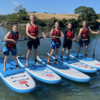There is a lot of talk, blogs and social sites discussing SUP Surf boarding. So we added this video to remind us of some of the basics.
We have also found this useful content from http://www.supsurfboards.co.uk/sup_etiquette.php
Naish put it beautifully – Please use respect and common sense when surfing an SUP. Just because you could catch every wave, doesn’t mean you should. Nobody likes a wave hog, give respect, and don’t be a kook!
General surfing rules say that priority is given to the closest surfer to the peak (peeling part) of the breaking wave, or the surfer that is furthest out, or that has been waiting longest. Given that most SUP are further out on a surf break that any other user, you could then claim priority on almost any wave! To reduce the chance of conflict it makes sense to (where possible):
- Find some space! You are more mobile than most surfers, if you can keep your distance then there is little chance of conflict.
- Catch waves that are breaking deep, and pull off before they reach the main surf or shore break.
- Try and look for waves that are peeling away from the crowds; learn to read ‘green’ unbroken waves from a distance and use this to your advantage.
- Catch the later waves in each ‘set’ or group of waves, this normally allows the main line-up of waiting surfers/bodyboarders to empty to some extent. This will give you a longer, hazard free, safer ride.
- Give waves/earn respect, if waves are sparse leave certain sets of waves to other users completely.
- Keep control – it’s better to pull off a wave if you are not 100% – your board is heavy and very hard, nobody is going to be happy if you kick it out and turn it into a loose missile. This is especially true if you are coming into shore through crowds of families with small children.
In addition it is worth using common sense when choosing where you are going to surf. Breaks that are known for surf longboarding will normally offer a smoother, longer breaking wave. In addition longboarders can be older and less aggressive than (younger) shortboarders. Breaks where there are deeper breaking waves to ride, or other less crowded areas will reduce your risk of conflict. As a sweeper you have the ideal means to get to breaking waves well off-shore and in hidden secret spots so use it to your advantage!







